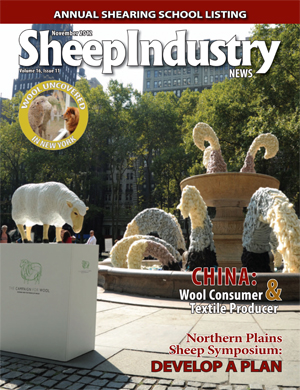According to a wide range of wool buyers and processors, paint-free wool remains the most desired type of wool because it can be utilized in a wide array of fabrics. It allows processors to eliminate a potential problem area that can be very costly when excessive amounts of paint or grease markers are not able to be scoured out completely in early processing stages. This gives both buyers and processors a wider range of use for the wool, regardless of other factors and reduces costs through processing. Both wool top mills and fabric makers have noted decreased issues in the amount of paint issues recently; however, they remind the industry that when these issues arise at the processing facility, costs skyrocket immediately.
They suggest that growers remain firm in their commitment to wool quality improvement by reducing all types of contamination.
Many range operations in the plains and mountain states need to be able to identify their sheep as they utilize public grazing lands. Herds can accidently mix under these conditions and cause hours and hours of sorting time to separate various herds. Many sheep producers utilize branding paint to identify lamb and ewe pairs as they are sorted and turned out into various management systems throughout the country. Thus, in terms of wool quality improvement, it behooves producers to be aware of potential processing issues when they utilize branding fluids and markers. From a cost standpoint, with paint at $30 plus per gallon, certainly using less of the product to cover more sheep increases efficiency and lowers overall cost.
Current recommendations in the U.S. Code of Practice for Wool Handling in the United States include the following do’s and don’ts.
Do’s of Paint Branding Sheep
- Shake and stir paint well. In colder weather, paint will thicken, so place can in warm water bath for 5-10 minutes. Paint manufacturers sometimes make recommendations about diluting agents. Read the label.
- Apply paint sparingly – only enough to make a legible brand.
- Use an application tool 4 mm wide – the length of this line: __ or the thickness of four credit cards.
- Let the excess paint run off the applicator before applying to sheep.
- Use a branding iron of minimal overall size – enough to recognize the sheep and only have minimal impact on wool quality. One letter/number is better than two to limit paint effects. In addition, open number or letters are better as they limit the amount of thick, globs of paint concentrated in one area.
- Brand on the head if possible; if not, on top of shoulders or on juncture of neck and shoulders as this area consists of lower-value wool than that on the middle of the back.
Don’ts of Branding
- Do not put paint in fire to warm it or thin it.
- Do not mix brands of paints.
- Do not let paint freeze.
- Do not dilute paint unless label allows this practice.
Wool buyers and processors have indicated that the most difficult paint to remove is usually applied to sheep with 1.5” of wool or more. This is evident in “winter bands” that are being formed in late fall to go on public land areas till shearing time in the spring. Excess amounts of paint results in hard, dry clumps of paint deep in the wool which are extremely difficult to remove during scouring. Some producers choose to remove the paint brands when fleeces are placed on classing tables at shearing time. This results in additional time and labor costs to the producer and removes 10 percent to 15 percent of the higher-valued wool from the center of the back – often sold at significant price discounts.
In the farm flock states, the use of markers on rams is an accepted practice in many areas. However, producers should be aware that these products are very difficult to remove from wool as these are oil-based products and are deeply imbedded into the wool in the rump areas of the ewes and chest areas of the rams. This wool needs to be completely sorted out at shearing time and kept separate, as this is a major wool contaminant in wool processing.


